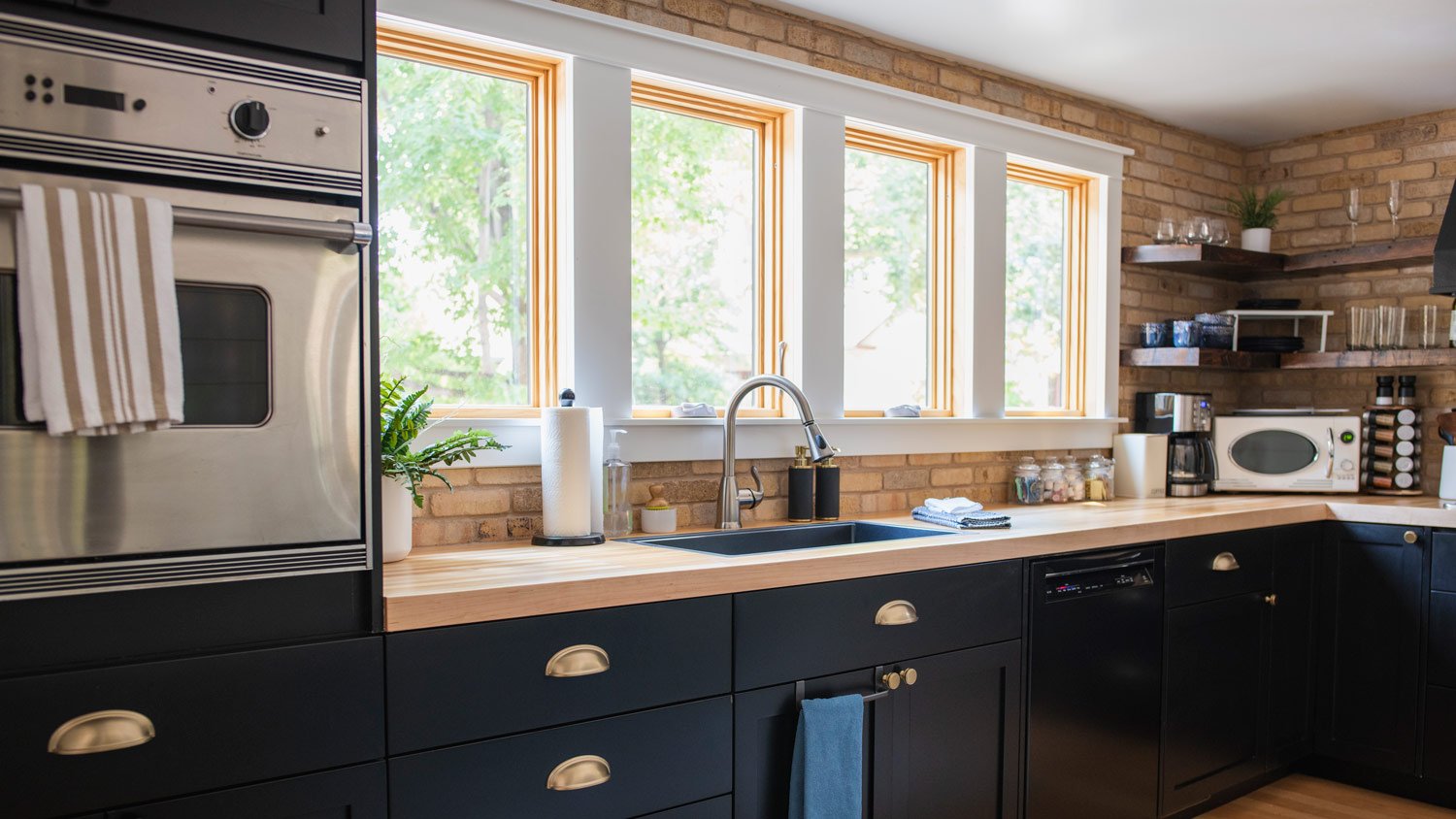How to Measure for Replacement Windows and Get the Perfect Fit
Grab a tape measure and a pencil


Whether due to a rogue baseball or regular wear and tear, eventually, it will come time to replace your windows. If you’re a handy DIYer, you can learn how to measure for replacement windows in a few simple steps. The process itself is easy, but precise measurements are essential for accurate quotes and ordering the right size window replacement. Use this guide to learn how to measure windows without the help of a professional.
Why You Should Measure Your Windows
There are several ways to measure for replacement windows depending on exactly which measurements you need. Regardless of how you measure, you’ll need the following:
Measuring tape
Pencil
Notepad
It’s fine for you to rely on your memory for your grocery list, but you’ll want to write down those exact numbers when you’re measuring for replacement windows. Unlike a piece of molding that can be trimmed if it’s not quite the right size, a replacement window cannot be trimmed to fit the frame, so keep that notepad handy when you’re ready to make the purchase.
Measuring your own windows can save you on added labor costs, but only if you take care to do it right. That’s why learning how to measure for replacement windows the right way is so essential.
Prepping to Measure Windows
Replacing windows is more DIY-friendly than adding new windows altogether. However, your window frames need to be in good condition or they won’t be structurally sound enough for replacement windows. Before measuring, inspect the condition of your window frames, sills, sashes, and trim for the following signs of water damage or rot:
Discoloration
Peeling or bubbling paint
Wood that is visibly rotten
Difficulty opening or closing
Wood that is soft or crumbles to the touch
Fog or condensation that you can’t remove
Gaps in the corners of the interior casing trim
Light shining through cracks around the frame
If your windows are damaged or are not square, you may need to contact a window frame repair service to remedy the issue before installing new windows.
How to Measure for Replacement Windows in 4 Different Ways
Whether you’re measuring to check that your window is square, only to get height measurements, to get a new window screen, or only to get width measurements, we’ve got all the steps you need to ensure your measurements are perfect.
Check If Your Windows Are Square
If you’re measuring for a replacement window, window screen, or storm window, it’s important to ensure that your current window frames are square. To be square means that all four corners are at perfect 90-degree angles. Any new windows you purchase will be square. If the current glass is lopsided, this could prevent the windows from opening properly. Here’s how to “check for square,” as the process is typically called:
From inside your home, place the end of your tape measure at the top right corner of the glass where the vertical and horizontal trims meet.
Hold the tape measure taut and measure diagonally to the bottom left corner where the two trims meet.
Record the measurement.
Take a second measurement diagonally down from the top left corner, just as you did for the other side.
Record and compare the two measurements.
If both measurements match within 1/4 of an inch, you can safely order replacement windows for a correct fit. If not, you will need to replace the window frame beforehand or order a new-construction window instead of a replacement window.
Measure Window Width

To measure the true width of a window opening, you’ll need to take three measurements from the top, middle, and bottom of the window.
Raise the window sash to expose the jambs, which are the vertical parts forming the sides of the frame where the sash slides up and down.
Ignoring the width of the trim, extend your tape measure straight across the bottom of the window from just inside the left jamb to just inside the right jamb.
Close the window and repeat this measurement from the middle and top of the window.
Compare your width measurements and write down the shortest of the three. This is your true window opening width.
Measure Window Height
To measure the true height of a window opening, you’ll need to take three measurements from the windowsill, which is where the sash rests when closed and which you can only access by opening the window. Note that the sill is not the horizontal piece of trim board that extends out from the wall. While often mistakenly called the sill, this is actually the stool.
Starting on the far left side of the window, extend your tape measure straight up from the windowsill vertically to the head jamb.
Ignoring the height of the frame and trim, record your measurement.
Repeat steps 1 and 2 from the center and right side of the window.
Compare your height measurements and write down the shortest of the three. This is your true window opening height.
Measure Window Screens
How you measure for window screens will depend on whether or not your window currently has a screen.
Replacing an Existing Damaged Screen
If your window already has a screen that you need to replace because it’s damaged, simply measure the width and height of the existing screen. These are the dimensions you’ll need when purchasing a replacement.
Adding a Screen to a Window
Pull your tape measure straight across the window horizontally to measure the distance between the screen channels on the window frame.
Subtract 1/8 inch from your measurement. This is your width dimension.
Raise the window sash and measure up from the lip, which is the ridge that holds a screen in place, along the screen channel to the sash.
Add 1/8 inch to the measurement. This is your height dimension.
Ordering Replacement Windows

After you’ve recorded the smallest width and height measurements (as width by height), you’re all set to get your replacement windows ordered. Replacements should be within 1/8 inch of your measurements, rounded down. You should also decide which type of replacement windows will work best for your home and budget, whether it’s vinyl windows, composite, or another style.
You may find windows close to the size you need at your local home improvement store, but it’s typically best to order custom windows based on your exact measurements for the perfect fit. Order online, talk to a customer service technician at your local home improvement store, or contact a local window contractor to finish the project.
Tips for Properly Recording Window Measurements
When you measure a window for replacement, accuracy is vital. Carefully record each measurement as you take it, and always record them as width by height. For example, if your windows are 60 inches tall and 34 inches wide, your measurement should read 34 inches x 60 inches. Round down each measurement to the nearest 1/8 inch.
If measuring multiple windows, label each set of measurements with the exact window location. For example, write down “east side bedroom window” with your measurement. Even if all the windows in a room look the same size, they may have slightly different measurements. To stay on the safe side, measure each window separately before you order new windows.
DIY vs. Hiring a Pro
Measuring for replacement windows is a simple DIY project, but not everyone will be comfortable replacing windows on their own. If you plan on replacing multiple windows, aren’t confident in your measuring skills, or are installing a custom or complex window design, hiring a local window installer can help you avoid problems like mold, code violations, cosmetic damage, and structural issues.
The cost for a replacement window ranges between $75 and $1,500 per window, depending on the type, size, and style of the window. These costs do not include labor, so this is what you’ll pay as a DIYer. To have replacement windows installed by a pro, you can expect to tack on an additional $100 to $800 per window, raising this cost range to between $175 and $2,300 per window.
In some markets, the labor cost effectively doubles the entire cost of the window, so keep this in mind when considering your window budget.
Barbara Bellesi Zito contributed to this piece.
Frequently Asked Questions
When determining the correct size of replacement windows you need for your home, you must take the horizontal and vertical measurements from inside, not outside. To measure the window horizontally, place the tape measure across the two inside window jambs. To take a vertical measurement, place the tape measure between the sill and head jamb.
The difference between a replacement window and a new construction window is that replacement windows are designed to fit right into the existing window frame in your home, which is why replacement windows are used to replace windows in existing homes. In contrast, new construction windows cannot be installed unless the existing frame is removed and replaced, which is why they are installed in new builds, not homes that have already had windows installed in window frames.
To measure a rough opening for a replacement window, take horizontal measurements from the bottom, middle, and top of the window for a total of three measurements. Next, take vertical measurements from the left, center, and right for another set of three measurements. The smallest of the three horizontal measurements and the smallest of the three vertical measurements are your rough opening dimensions (width by height).















